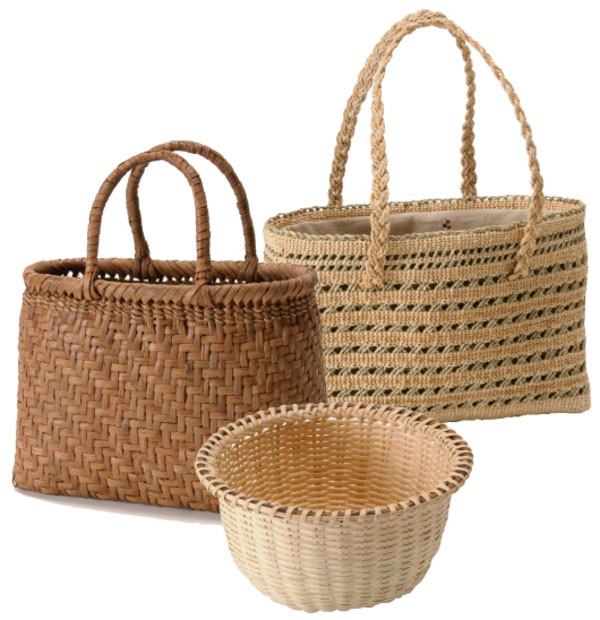 Photo:Fukushima Prefecture
Photo:Fukushima Prefecture
- Wood, bamboo crafts
- Fukushima
Okuaizu Basketry Oku aizu amikumi zaiku
Traditional crafts and techniques
made from natural materials
Description
What is Okuaizu Basketry ?
Okuaizu Basketry, called Okuaizu Amikumi Zaiku in Japanese, is basketry produced around Mishima Town, Onuma County, Fukushima Prefecture. As this mountainous area in the Okuaizu region has much snow and farmers are unable to work in the fields in winter, the craft of basketry has been handed down from olden times as handwork during the snowy season. There are three different types of products each made from plants growing in this region; the hiroro crafts made from carex multifolia, yamabudo crafts made from crimson glory vine, and matatabi crafts made from silver vine. Okuaizu Basketry is distinguished by the use of local natural materials and their superb hand-weaving, which although simple, has a distinctive delicacy. As for hiroro crafts, hand baskets, large baskets, and shoulder baskets are made by fine-weaving the carex multifolia into a finish resembling lace stitches. For yamabudo crafts, robust baskets and confectionery bowls are made with the tough crimson glory vine. For matatabi crafts, cooking utensils are mainly produced as silver vine baskets are pleasant to the touch and can make good strainers. Okuaizu Basketry is a traditional craft embodying the spirit of the art of craftsmanship, in which local people in harmony with nature make the daily necessities of life.
History
Fragments of simple basketry and rope were discovered at the Arayashiki archaeological site in Mishima Town, proving that such skills and techniques already existed in the area as far back as the Jomon period (14,000 to 300 BC). More recently, in old documents such as the “Aizu Nosho (Book on Agriculture in Aizu)” written in 1684 and “Toyu Zakki (Record of Journey to the Ou Region)" in 1788, descriptions of basketry can be found; although the origins are not clear, it would seem Okuaizu Basketry items have been made on a daily basis in this region for at least several hundred years. The skills have been handed down to present, but during the late 1960s, due to an aging population, the number of basket weavers decreased. Mishima Town was concerned that if nothing was done, the craft would be lost. Aiming at the establishment of a local industry, the town embarked on a movement to promote the use of such handcrafted utensils and baskets on a daily basis. This campaign has spread throughout the region over the years and at present, more than 100 artisans are keeping the skills and techniques of Okuaizu Basketry very much alive.
General Production Process
- 1. Harvesting There are three types of Okuaizu Basketry: matatabi crafts, hiroro crafts, and yamabudo crafts. The following production process is for a matatabi craft basket. The thick and mature silver vines are harvested from November onward until the first snow fall.
- 2. Peeling The silver vine bark is peeled off.
- 3. Splitting The remaining vine is split vertically into 4 or 5 strips.
- 4. Core making A knife or similar tool is used to shave off the soft parts and make even thinner strips. The process from harvesting to core making must be carried out straightaway before the vine dries out.
- 5. Weaving the bottom Uniformly wide strips are woven to make the basket bottom. The techniques used are the nihontobi-ajiro-ami (two strip herringbone pattern weaving) and yotsume-ami (open lattice weaving).
- 6. Weaving the sides When the bottom is completely woven, the strips are bent up to form sides and the weaving continues. The techniques mainly used are either nihontobi-ajiro-ami or zaru-ami (colander style weaving).
- 7. Finishing the rim When the sides are woven to the intended height, the strips are rolled over and the rim is fastened in place.
- 8. Reinforcing the rim The rim is reinforced using the vine of Berchemia racemosa or other plants.
- 9. Drying Traditionally under the airy and sunny eaves of a house, the basket is exposed to cold weather or snow to dry. Exposure to cold wind increases its strength and reflections from the snow bleaches its color.
Where to Buy & More Information
Mishima Seikatsu Kogeikan
-
Address
-
Tel.+81-241-48-5502
-
ClosedMondays (open if Monday is holiday and closed the next day), national holidays
-
Business Hours9am to 5pm
-
Website
See more Wood, bamboo crafts
- Hakone wood mosaic
- Iwayado traditional chest
- Kaba cherrybark woodcrafts
- Odate bentwood
- Inami wood carvings
- Matsumoto furniture
- Beppu bamboo crafts
- Edo wood joinery
- Ichii woodcarvings
- Suruga bamboo crafts
- Edo bamboo fishing rods
- Kishu bamboo fishing rods
- Kamo traditional chest
- Kyo wood joinery
- Miyakonojo archery bows
- Osaka carved wooden panel
- Miyajima woodwork
- Nibutani carved wooden tray
- Okuaizu Basketry
- Echizen traditional chest
- Kasukabe traditional paulownia chest
- Katsuyama bamboo crafts
- Osaka karaki wood joinery
- Takayama tea whisks
- Toyooka wicker crafts
- Akita cedar tubs and barrels
- Nagiso woodturning
- Kishu traditional chest
- Nagoya traditional paulownia chest
- Osaka bamboo screens
- Osaka-senshu traditional paulownia chest
- Sendai traditional chest































































































































































































































































































